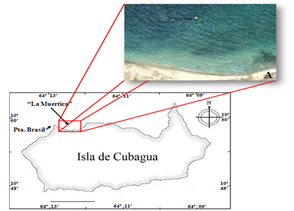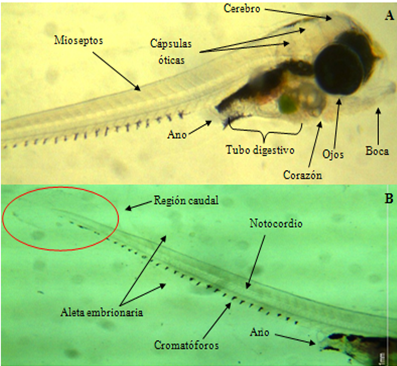Journal of
eISSN: 2378-3184


Mini Review Volume 12 Issue 2
1Escuela de Ciemcias del Mar, Pontificia Universidad Católica de Valparaiso, Chile
2Escuela de Ciencias Aplicadas del Mar, Universidad de Oriente, Venezuela
Correspondence: Patti Jose, Aquaculture Laboratory, Aquaculture Department of the Universidad de Oriente - Nueva Esparta Nucleus (UDO-NE), School of Applied Marine Sciences (ECAM), Venezuela
Received: May 25, 2023 | Published: June 14, 2023
Citation: Zuhelén V, Jose P, John G. Description of the first larva of the blenny Parablennius marmoreus (Osteichthyes: Blenniidae) obtained in captivity under controlled conditions. J Aquac Mar Biol. 2023;12(2):151-153. DOI: 10.15406/jamb.2023.12.00368
The characteristics of newly hatched Parablennius marmoreus larvae obtained in captivity under controlled laboratory conditions are described. Adults were collected on the island of Cubagua (10º 49.40' 99'' N and 64º 11.59' 37'' W) Venezuela, and they were transferred to the breeding room of the ECAM UDO-NE where they were kept in circular fiberglass tanks with 20 liters of filtered seawater. The larvae hatch between 5 and 6 days (25.6-31.6 ºC) after spawning, have a total length of 2.91 ± 0.34 mm, 97 beats per minute, the mouth and anus are open, developed and pigmented eyes, small and rounded pectoral fins, peritoneal pigmentation and chromatophores in the ventral part, the larva presents active swimming.
Keywords: Parablennius marmoreus , blennys, larval description, captivity
The species Parablennius marmoreus inhabits very shallow bottoms, generally at a depth of less than 10m on a consistent substratum, with stones and/or gravel, in areas of clear water, but not necessarily with coral formations. It is also caught in Thalassia testudinum meadows. It is distributed from the northeastern United States, Bermuda and the Bahamas, to northern South America. In Venezuela it is a common species and sometimes very abundant in certain areas, such as the Charagato Bay on the island of Cubagua.1
The blenny P. marmoreus is of great interest in aquaculture. Its attractiveness as an ornamental fish is due to the variety of colors it presents. Wabnitz et al.,2 point out that according to the data recorded by the Global Marine Aquarium Database (GMAD), between 1997 and 2002, blennys represented 2% of the total trade of 24 million marine ornamental fish, made up of 10 main groups. (Pomacentridae, Pomacanthidae, Acanthuridae, Labridae, Gobiidae, Chaetodontidae, Callionymidae, Microdesmidae, Serranidae, and Blenniidae).
There are few known larval descriptions of the genus Parablennius. Among those that stand out, Parablennius pilicornis (Faria et al., 2006), Parablennius marmoreus,3 Parablennius ruber,4 Parablennius gattorugine and P. ruber.5
In this case, the studies of the first life stages of the species P. marmoreus are not very complete and the descriptions that have been made of larval stages are made from eggs or larvae obtained in the environment. This study describes the first larva of the blenny P. marmoneus obtained in captivity under controlled laboratory conditions.
P. marmoreus larvae were obtained from captive-maintained broodstock. The adults of P. marmoreus were collected inside the shells of dead barnacles that were attached toa semi-sunken vessel, approximately 20 m long, which is located 90 m from the coastline, in an area called "La Muertica" (10º 49.40' 99'' N and 64º 11.59' 37'' W, Figure 1A), on the island of Cubagua, Venezuela.

Figure 1 Map of the island of Cubagua, collection area for Parablennius marmoreus spawners. (A) “La Muertica” (10º 49.40' 99'' N and 64º 11.59' 37'' W), located near the Punta Brasil lighthouse. Image taken from Google earth (Date: 07/06/2010).
The broodstock were kept in tanks.50-litre capacity white fiberglass bowls. In this case, the water used was filtered through an artisanal sand filter and sterilized with UV light. Daily changes of 20% of the water were made.
The reproducers were satiated with frozen myscidaceans, collected from the mangrove pot located in the La Restinga lagoon. (10º 58.07' 08'' N and 64º 10.27' 32'' W), on the island of Margarita, Venezuela.
For the description of the larvae, an OLYMPUS model BH2 microscope was used and using a MOTIC brand MOTICAM 2300 digital camera, with 3.0 mega pixel resolution, adapted to the microscope, the larvae were photographed, and using the camera's digital program. The following characters were measured: total length (LT), post-orbital distance (DPO), rostrum length (LR), eye diameter (DO), digestive tract length (LTD), neck length, and the mouth (LB).
During the experience, salinity was measured with a Milwaukee model MR100ATC refractometer with an appreciation of ± 1 ps, and the temperature and dissolved oxygen of the water with a YSI model 550A, with an appreciation of ± 0.1 ºC and ± 0. 01mg/l respectively.
The larval description was made from 12 spawnings obtained in captivity under controlled laboratory conditions, between the months of July and November 2010. The larvae (hatched between 5-6 days after spawning; 25.6-31.6 ºC) recently hatched from P. marmoreus (Figure 2) present 97 beats per minute (heart with 2 chambers), the average total length was 2.91 ± 0.34 mm, myoseptia completely visible, with 30 chromatophores along the notochord. Well developed eyes (OD = 0.28 ± 0.03 mm), with already formed lenses and golden coloration. The mouth completely open (LB = 0.66 ± 0.12 mm), ready for exogenous feeding, because the larvae hatch without yolk, that is, it is completely reabsorbed. Differentiated jaws and formed lips. LR was 0.10 ± 0.05 mm. The otic capsules were observed with their 2 pairs of otoliths, sagittal and lapilli (saccular and utricular). DPO was 0.87 ± 0.23 mm and LTD was 0.88 ± 0.19 mm. Peritoneal pigmentation. The larva presents a large number of completely visible myoseptae, with 30 chromatophores along the notochord in the ventral part, between the anus and the tail (Figure 3).

Figure 3 Larva of Parablennius marmoreus. A) Structures of the anterior and middle region of the larva: mouth, eyes, brain, heart, otic capsules, digestive tube, anus and myoseptus; B) Structures of the middle and posterior region of the larva: anus, notochord, embryonic fin, chromatophores, caudal region.
Body fluids were visible throughout the body (from the heart to the caudal region of the larva, and vice versa). The embryonic fin is present and visible from the dorsal region of the head to the ventral region where the anus is located. The pectoral fins small and rounded. The larva presents active swimming. The larva presents a large number of completely visible myoseptae, with 30 chromatophores along the notochord in the ventral part, between the anus and the tail (Figure 3).
The embryonic fin is present and visible from the dorsal region of the head to the ventral region where the anus is located. The pectoral fins small and rounded. The larva presents active swimming. The embryonic fin is present and visible from the dorsal region of the head to the ventral region where the anus is located. The pectoral fins small and rounded. The larva presents active swimming.
The salinity remained at 37 psu during the 5 months that the experience lasted. Dissolved oxygen was 5.7 ± 0.03 mg/L. The average temperature was 28.7 ± 1.2 ºC, varying between a registered minimum of 25.6 and a registered maximum of 31.6 ºC (Table 1).
|
Months |
Temperature (ºC) |
Oxygen (mg/L) |
Salinity |
|
Parameters |
|||
|
July |
28.48±1.04 |
5.55±0.35 |
37 |
|
August |
29.21±1.14 |
5.81±0.33 |
37 |
|
September |
29.12±1.88 |
5.68±0.33 |
37 |
|
October |
28.59±1.88 |
5.79±0.15 |
37 |
|
November |
29.32±1.00 |
5.69±0.24 |
37 |
Table 1 Average values of the physicochemical parameters (temperature and oxygen) taken with theYSI, during the experience
The larvae of P. marmoreus hatched between 5 and 6 days after spawning (25.6-31.6 ºC), contrary to what was reported by Faria et al.,6 who indicate that Parablennius pilicornis hatched between 9 (20-21 ºC) and 14 days (17-19 ºC) and Faria et al.,5 mentioned that Parablennius gattorugine hatched between 15 and 16 days (18 ºC) and between 30 and 31 days (13 ºC), while Parablennius ruber hatched between 14 and 15 days (17 ºC). These differences in terms of hatching time in these species may be due to what was explained by Thompson and Riley,7 who pointed out that low temperatures can prolong incubation periods, while high temperatures can accelerate this process.
In this work, the newly hatched larvae of P. marmoreus presented an average of 2.91 ± 0.34 mm TL, unlike what was reported by Wittenrich,3 who mentions that the newly hatched larvae from a collection of eggs obtained in the medium of P. marmoreus , they presented a TL of 3.2 mm. While for representatives of the same gender, higher sizes are reported. Such is the case of Faria et al.,6 who state that the TL of newly hatched larvae of P. pilicornis is 3.1 ± 0.07 mm. On the other hand, Villegas et al.,4 mention that the TL in larvae obtained from the P. ruber medium is 4.65 ± 0.25 mm. Faria et al.,5 report a lower TL in recently hatched larvae of P. ruber (LT = 4.10 ± 0.07 mm), and also point out that P. gattorugine presents a TL of 5.20 ± 0.07 mm.
Certain features such as open anus and mouth, differentiated jaws, formed lips, completely absorbed yolk, open opercula, visible otoliths (sagittal and lapilli), fully formed and pigmented eyes, small and rounded pectoral fins, presence of chromatophores on the ventral part of the larva (between the anus and the tail) and peritoneal pigmentation, were observed in newly hatched larvae of P. pilicornis,6 P. gattorugine, P. ruber,5 and P. marmoreus (present study).
In this study, 30chromatophores in the ventral part of the larva between the anus and the tail, as reported by Faria et al.,6 for P. pilicornis , likewise, mention that recently hatched P. pilicorinis larvae differ from others of the same genus because they present 6 to 7 preopercular spines, unlike P. ruber which presents 2 to 4 spines and in P. gattorugine it is absent (Faria et al., 2010). In this study, no preopercular spines were observed in the larvae of P. marmoreus.
The larvae of Parablennius marmoreus they hatch with a total length of 2.91 ± 0.34 mm, yolks completely absorbed, anus and mouth open, pectoral fins and digestive tube formed, peritoneal pigmentation and chromatophores on the ventral part of the larva. The larva presents active swimming.
None.
None.

©2023 Zuhelén, et al. This is an open access article distributed under the terms of the, which permits unrestricted use, distribution, and build upon your work non-commercially.